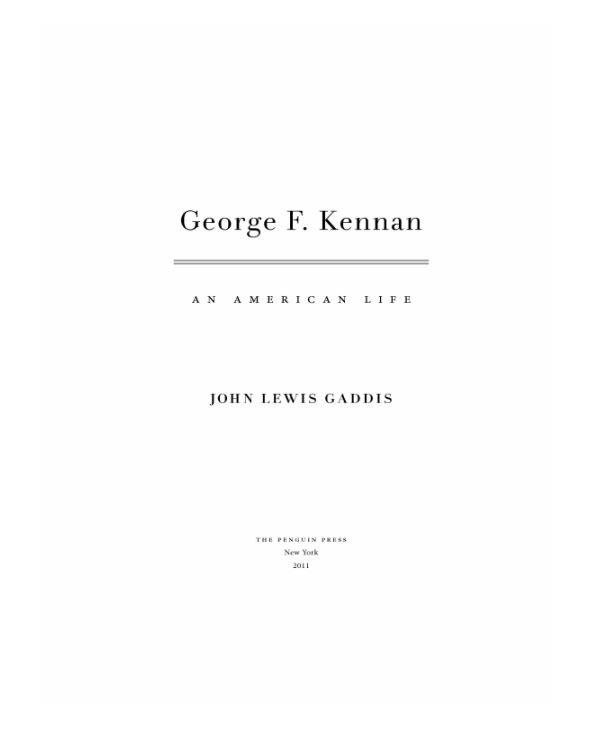
George F. Kennan
An American Life
کتاب های مرتبط
- اطلاعات
- نقد و بررسی
- دیدگاه کاربران
نقد و بررسی

August 15, 2011
No one is better suited than Gaddis to write this authorized biography of George F. Kennan: the noted Yale cold war historian had total access to Kennan’s papers as well as to his family members and associates—Kennan so trusted his biographer that he remarked, “write , if you will, on the confident assumption that no account need be taken of my own reaction... either in this world or the next.” Through his privileged relationship with Kennan, Gaddis reveals the man behind the public persona as an agonized and fragile individual who often felt alienated from the U.S. and his fellow citizens, despite his tireless service to his country. In addition to the intimacies of the work, Gaddis offers critical analyses of Kennan’s key roles as diplomat, policy maker, and scholar of Russian history. Unsurpassed in his strategic vision during the cold war, Kennan is credited with being responsible for much of America’s eventual victory, and therein lies the impetus behind this remarkable biography. Adroitly managed (if occasionally barnacled with extraneous facts), Gaddis’s work is a major contribution to Kennan’s legacy and the history of American foreign policy.

August 15, 2011
The long-awaited authorized biography of George F. Kennan (1904–2005), the creator of America's Cold War containment strategy.
Kennan commissioned Gaddis (History/Yale Univ.; The Cold War: A New History, 2006, etc.) to write his life story back in 1981, on condition that the work not be published until after his death. Then 75, Kennan lived to be 101. Now the story can be told, and it is well worth the wait. At the beginning of his diplomatic career in the late 1920s, Kennan, along with a handful of others, was recruited into the Russian Studies section of the State Department's Eastern European division by Robert Kelley, and he helped FDR's Ambassador William Bullitt open diplomatic relations. Gaddis has had unique access to official papers, Kennan's own publications and documents, the diary that he kept throughout his life and his correspondence, especially to his sister. This access will be especially revealing for those interested in discovering more about the period from 1944 to 1952, which saw victory in World War II, the development of the atomic bomb, the adoption of containment, the beginning of the Cold War and the adoption of the Truman Doctrine. Throughout the book, Kennan's papers make clear what he was responsible for, and what he wasn't. Gaddis also provides intriguing accounts of Kennan's work with the Marshall Plan, his establishment of a training program for upcoming officers in the military and diplomatic service and his work with Frank Wisner and the Office of Policy Coordination. But of equal interest are his later life at Princeton's School of Advanced Studies and his relations with subsequent Presidents, including Bill Clinton, whose expansion of NATO after the collapse of the Soviet Union Kennan forcefully objected to.
A well-rounded treatment of the life of a man who made significant contributions to his country and the world at large.
(COPYRIGHT (2011) KIRKUS REVIEWS/NIELSEN BUSINESS MEDIA, INC. ALL RIGHTS RESERVED.)

June 1, 2011
One of our most significant diplomats, George F. Kennan was responsible for this country's four-decades-long policy of containment regarding the Soviet Union. Gaddis, the Robert A. Lovett Professor of History at Yale University, began interviewing Kennan almost 30 years ago, also plunging into his personal papers with plans to write a definitive biography. But since these papers covered not only politics but deeply personal matters, including Kennan's struggle with depression, the two men agreed that the work would not appear until after Kennan's death. Should be an eye-opener,
Copyright 2011 Library Journal, LLC Used with permission.

Starred review from October 1, 2011
Diplomat and historian Kennan (19042005) cooperated with this biography that in its documentary thoroughness and lucidity about his enigmatic, fragile personality must stand as the definitive portrait. Of undoubted brilliance in his adulthood, Kennan throughout his life was acutely sensitive, solitary, often pessimistic, but ultimately philosophicalan outlook encapsulated in his Around the Cragged Hill (1993). The youthful sources of those traits Gaddis roots in feelings of abandonment provoked by the premature death of Kennan's mother, in testing experiences in military school and Princeton University, and in rapidly maturing appreciations for the behaviors of governments, his own and others, while he was a young foreign service officer in the 1920s and 1930s. An inveterate diarist and letter writer, Kennan probably deluged Gaddis with his interior life, which seemed beset by self-doubt and despair over matters personal (Kennan apparently had several affairs) and public. Apart from the years 194650, politicians ignored his advice and prophecies on world politics, but within that window, Kennan was uniquely influential as the enunciator of containment policy toward the Soviet Union during the early Cold War. The work of an eminent historian of that very subject, Gaddis' biography is doubly significant and a new essential in any reading, recreational or scholarly, in the history of American foreign policy.(Reprinted with permission of Booklist, copyright 2011, American Library Association.)

























دیدگاه کاربران